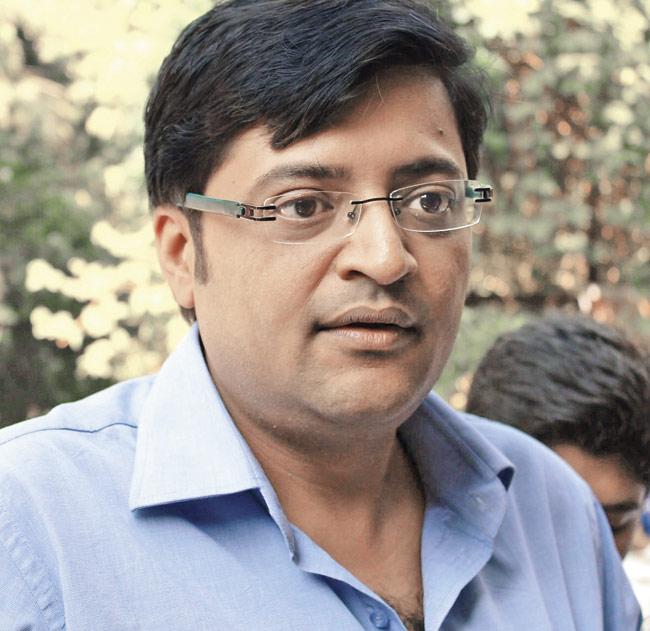Arnab Goswami, the star anchor on the Times Group’s English news channel Times Now, is fast becoming a symbol of all that is right and wrong with India’s news industry

 Arnab Goswami, the star anchor on the Times Group’s English news channel Times Now, is fast becoming a symbol of all that is right and wrong with India’s news industry. That is evident from the jokes, spoofs and news stories in mainstream newspapers and magazines on him and his style of anchoring.
Arnab Goswami, the star anchor on the Times Group’s English news channel Times Now, is fast becoming a symbol of all that is right and wrong with India’s news industry. That is evident from the jokes, spoofs and news stories in mainstream newspapers and magazines on him and his style of anchoring.
This, however, is not about Goswami, but about what the whole discussion around him points to. It suggests a shift in the way we view news and react to it. The distance between the news provider and the audience has completely crumbled. This takes democracy to another level. It is not clear though whether this is good or bad.
ADVERTISEMENT

The spoofs and discussion around Goswami’s style is a big pointer to how much the audience for news has changed
Note that Goswami just happens to be a popular example to make the point. There are similar discussions, spoofs or parodies of dozens of other media people. A quick look at some of the spoofs.
At a recent public function former Union minister Arun Shourie did a superb take-off on Goswami. Just Google it for a quick watch. Shourie uses his sharp wit to create a discussion around a fire in a TV studio that Goswami discusses in his trademark, ‘The nation demands an answer,” style.
The point Shourie was trying to make was that the quality of discourse or discussion on national forums is plummeting and has been lost in the popularity of the two minute plus clipping. Then there is one from The Viral Fever which has a podgy anchor adopting Goswami’s style to host a show with lookalikes of Arvind Kejriwal, Aditya Chopra, Meenakshi Lekhi and film critic Mayank Shekar.
The show then goes to autocratically tear apart the film studio for poor films with the Kejriwal clone who heads Bollywood Aam Aadmi Party or BAAP, insisting that a revolution was needed to improve their quality.
The 16 minute video is hilarious and yet makes a comment on the quality of news debating, on politics, films and everything that is India. It has got just under 2.5 million views on YouTube and is being passed around furiously on Facebook.
They emphasise that the democratisation of news in every sense of the word is still going on. Indians are luckier than the nationals of dozens of other countries such as China, Egypt or the Saudi Arabia.
We have the freedom to access and read or watch impartial news and analysis and to comment on it. But the confluence of two factors hyper-competition and the growth of online are taking this freedom to another level.
India has a record 135 news channels, about 86,000 plus registered publications and thousands of websites. As they grope around for things to fill their pages, hours and servers, these multitude of brands combined with rising Internet penetration (227 million online) and the boom in devices such as notepads and mobile phones, have stretched this freedom further.
Now audiences in India are enjoying the ability to discuss this news in public, tear it apart, laugh at it, or accuse it of biases. This was impossible earlier. The letters to the editor page, random comments on websites or an SMS or tweet on a news show was the level of interaction we had with news.
This new level of involvement from amateur, mature and purely ignorant viewers and readers is wonderful and scary. It is wonderful because it will eventually become the trigger for media houses to keep the noses and houses clean and for journalists and editors to do a better job.
It is scary because there is this whole bunch of untrained, inexperienced people who can now say anything about news generated by people who are trained for years. You could argue that the latter is more true for print, an older industry. In most serious newspapers rookie reporters cannot offer an opinion.
They have to learn to research, weigh and analyse facts for years before editors start taking them seriously. But now, all sorts of people can comment on something that a trained person is saying or doing. It is a bit like patients critiquing a doctor’s methods or his analysis.
Shourie’s is probably one of the few spoofs that came from someone who is well-read and has been a journalist himself. He has the stature to make fun of Goswami and get away with it. The others are just parodies of the mainstream media that are fun to watch.
And most editors and journalists know better than to take them seriously. It is when these parodies start becoming ignorant or unfounded allegations disguised as humour, or reputation-destroying comments is when the trouble starts. For now let us just laugh at the fun stuff.
The writer is a media specialist and author. Follow her on twitter at https://twitter.com/vanitakohlik
 Subscribe today by clicking the link and stay updated with the latest news!" Click here!
Subscribe today by clicking the link and stay updated with the latest news!" Click here!







